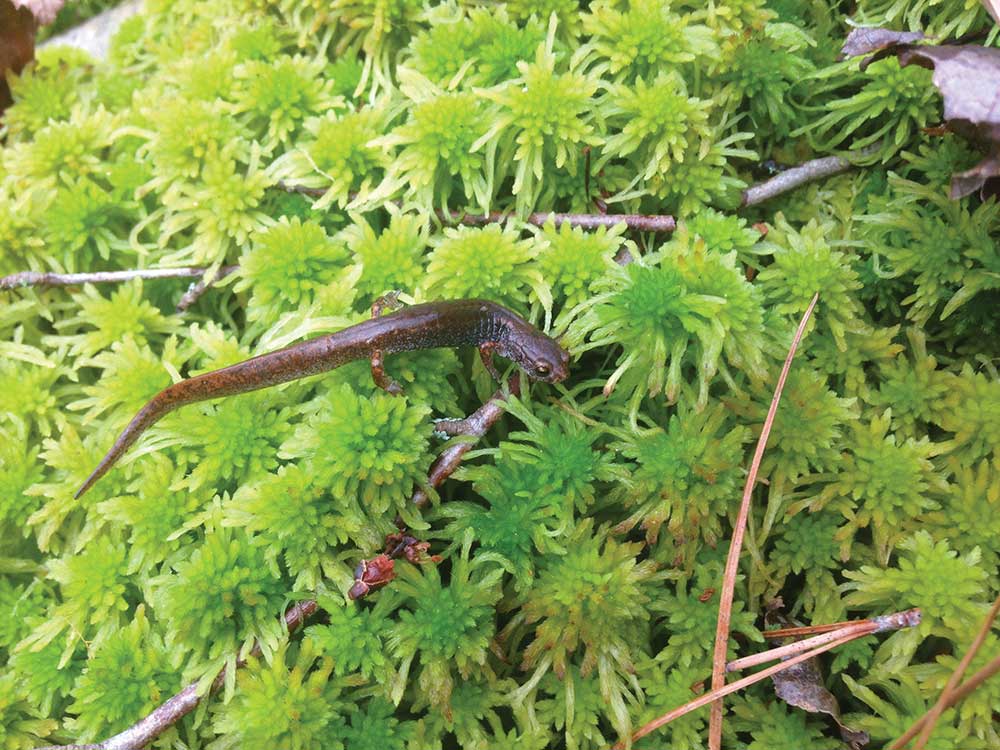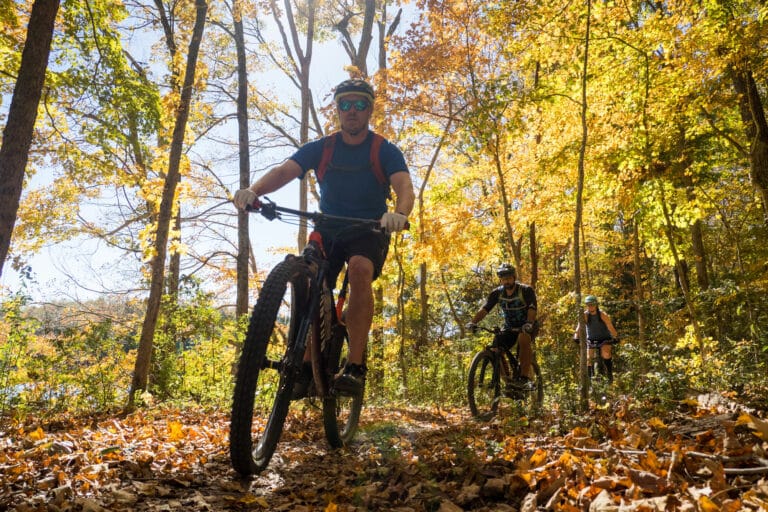Southern Appalachia shelters more species of salamanders than anywhere else on the planet
Walk into Dr. Michael Sears’ classroom at Clemson University, and you might see a global heat-map of salamander diversity projected across the screen. You’ll notice at once the anomaly—a world of cool blues and grays, punctuated by two small splashes of color: a brushstroke of simmering yellow smeared liberally up the east coast of North America, and, at its heart, in the bosom of the Appalachians, a warm, flaming ember of deep orange. It’s unexpected, and it glows like a smoldering secret.
“Most people don’t realize,” Dr. Sears says, “that they live in a place where they can see more salamanders than anywhere on the planet. It’s the global hotspot for salamander biodiversity.”
Some call it a futile task to determine the precise number of salamander species present in the southeast; taxonomic classification systems are imperfect, and certain species are often split into new groups, while others are re-combined.
“The last number I saw was just north of a hundred species,” says Dr. Kyle Barrett, an Associate Professor of Wildlife Ecology and Conservation at Clemson.
Depending on which approximation you consider, this means that roughly 20% of all world species can be found in the Southeastern United States—a fact that often goes overlooked.
“It’s a relatively under-studied group,” Dr. Barrett says. “One of the things that drew me to them is that we just don’t know that much about them.”
One thing we do know, however, is that salamanders play a crucial role in the environment.
“They’re the transition from invertebrates to vertebrates,” explains Dr. JJ Apodaca, Assistant Executive Director and Director of Science for the Amphibian and Reptile Conservancy. “And they’re the most abundant vertebrate in the system.”
And what, then, would happen if they were to disappear from this system?
“You would see trophic collapse,” Kat Diersen warns. She’s the Southeast Representative for Defenders of Wildlife, and spends a large portion of her efforts on conservation projects related to these species.
Here’s something else we know: salamanders are in trouble.
“More than 50% of all salamanders are imperiled,” Dr. Apodaca explains. “And it could go either way. We’re really at this turning point.”
A range of scourges, from climate change, to habitat destruction, to current and future pathogens, all threaten the treasure trove of salamander biodiversity sheltered here in the southeast. Yet, throughout the Blue Ridge and beyond, some of the greatest conservationists, biologists, and educators have begun to outline a path to survival for these unique amphibians and the ecosystems that rely on them. The only question that remains is this: can we stop this next extinction crisis before it begins?
“There’s a range of potential futures out there,” Kat Diersen warns, contemplating the unknown roads ahead, “and it really does matter what we do.”

Climate
“I think the next fifty to a hundred years are going to be interesting,” Dr. Sears says. Much of his work revolves around climate studies, and the potential impacts of change on species like these. And, while it’s difficult to accurately predict the effects of a changing climate, there are a few things we know with certainty.
“One of those is that it’s going to get warmer,” says Dr. Barrett. “Another is that precipitation patterns are going to change—how they’re going to change is where the uncertainty lies. But those two changes coupled together are not good news for most amphibians.”
“If you have long periods of drought,” Barrett continues, “especially with increased temperatures, these changes are likely to restrict their range and the amount of time they have to forage, and that means less reproduction and population decline.”
What makes this situation particularly dire to salamanders is their isolation—over the millions of years salamanders have evolved in the southeast, the various mountain ranges have acted as natural barriers to connectivity. Certain species prefer lower elevations while others prefer higher, and this separation has led to the emergence of unique, distinct populations in critically isolated regions. There are a handful of species, such as the Pigeon Mountain Salamander, that exist only on one or two mountaintops.
“These are species that don’t move very much,” explains Dr. Apodaca, “and they’re tied to small geographic areas, so if the climate shifts drastically, we see really negative consequences.”
“The idea is that as it gets warmer, they’ll just keep going up mountains to where it’s cooler,” says Dr. Sears. “But they’re going to run out of space at some point. And what makes that more dire here is that you’re losing little pockets of genetic diversity that don’t exist anywhere else. So if on that mountaintop is the only place you have that species, and it gets lost, that’s not coming back.”
Unfortunately, there exists another critical impact that a changing climate may play for salamanders: it may open the door to a new threat never before seen on the North American continent.
Pathogens
“Most diseases have optimal conditions in which they thrive,” says Diersen. “As conditions here change, they may become favorable to novel diseases and pathogens, introduced from outside. Climate change is going to make all of our critters more vulnerable to that future threat. And that’s a ticking time-bomb.”
Pathogens—fungal infections in particular—are by no means an entirely new threat to southeastern salamanders. They’ve so far endured Bd (the well-known “Chytrid” fungus that continues to decimate global frog populations) and are at this very moment facing down a range of ranaviruses across the U.S.
But there exists another, more formidable threat waiting like a marauding conquerer across the sea: BSal.
“That’s the big one,” says Dr. Amanda Duffus. She’s a member of the Diseases, Pathogens & Parasites Task Team for the Southeast Partners in Amphibian and Reptile Conservation. “It originated in southeast Asia, and it was brought to Europe, they think, through the pet trade.”
“It’s currently killing with 100% effectiveness certain salamandrids,” says Mark Mandica, Founder and Executive Director of the Amphibian Foundation.
Mark also works with a BSal taskforce, and is familiar with many of the conservation practices that would become necessary should BSal indeed manage to cross the ocean. And Mark agrees: BSal coming to America would be devastating.
“We’ve been operating under the assumption that it’s just a matter of time. That it will get here eventually. And that we need to be ready to act.”
The Amphibian Foundation already has experience with the preservation of endangered salamanders—they’re the only captive breeding facility for the Frosted Flatwoods Salamander, a species that’s suffered a 90% loss since the year 2000.
“At first we just focused on keeping them alive. We’ve done that, I’m happy to say, and now we have some very healthy salamanders. But they’ve never been bred in captivity, so that’s what we’re focusing on now.”
The problem is that these programs are notoriously difficult to carry out successfully for a single species—not to mention the hundreds that would be impacted if BSal were to reach the southeast.
“By the time we get involved in our captive propagation programs, in pulling animals from the wild to keep them from going extinct, that says that every possible plan has already failed,” Mark says. “It’s literally the last hope. And if that fails, the species goes extinct.”
Habitat
“I can say this for basically any threat,” says Dr. Apodaca. “There’s really one way to prepare—and that’s to keep intact large populations with lots of genetic diversity. And habitat destruction underlies all of this.”
“A lot of species will tolerate an increase in a single stressor,” Barrett explains, “but then when you add a second or a third, that’s when you see sharp population declines.”
“You open up a forest,” says Dr. Sears, “and it gets warmer. It gets drier. You decrease connectivity between populations.”
As many resources as we devote to staving off pathogens like BSal, there’s still the likely probability that they’ll arrive nonetheless. In a similar fashion, climate change has already proven itself notoriously challenging to manage with the resources currently devoted to the effort. The preservation of habitat, therefore, stands as the last best hope for preserving the biodiversity of salamander species in the southeast.
“Protecting the integrity of the habitat that these species rely on,” says Ben Prater, Southeast Program Director for Defenders of Wildlife, “is probably the most fundamental thing we can do to preserve these species.”
“Over half of all people in the U.S. live in urban areas,” says Dr. Barrett. “And we know there’s going to be pressure to develop—so can we at least make some recommendations for a way to do it that won’t create these impenetrable barriers for salamanders?”
Organizations like Tangled Bank Conservation, founded by Dr. Apodaca, have recently emerged to identify priority conservation areas, to determine where efforts ought to be concentrated in order to ensure optimal population connectivity and genetic diversity. Similarly, groups like Defenders of Wildlife work closely with public and private landowners to foster cooperation and compromise.
“It is absolutely possible for communities to coexist sustainably with wildlife,” Kat says. “Part of good conservation for these underdog species is engaging landowners where they are, understanding their needs, and presenting value to them in a way that creates win-win outcomes for communities and wildlife.”
“If you think about the threats they’re facing now,” Ben adds, “many of them are truly novel. But I believe in the adaptive and resilient aspect of nature, and have always given credence to the idea that if we protect enough habitat and ensure the quality of those habitats, there will always be a future for salamanders.”
Future
“For me, it goes deep,” says Ben Prater. “I grew up flipping rocks and logs in streams. And I can remember that sense of discovery and awe when I’d find this glistening, brilliantly colored animal living in the dirt.”
This childhood connection to the outdoors, relatable or not, is perhaps the best method of building relationships with these species. And today, it’s getting harder to come by.
Patrick Brannon is the Outreach Coordinator for the Highlands Biological Station, and spends a great deal of his time in K-12 classrooms, working to build connections between students and salamanders.
“A lot of these kids aren’t locals,” Brannon says, “and haven’t really experienced salamanders. And even the local ones don’t necessarily spend much time in the woods. So getting them outside, and showing them what’s there—especially the things you don’t normally see, the ones you have to dig for—and trying to get them enthusiastic is key.”
Mark Mandica, too, has come to understand the importance of education and outreach—it’s now a priority of the Amphibian Foundation, which offers classes and internships to help foster connections with amphibians.
“We have successfully put salamanders in the hands of people who didn’t know what a salamander was,” Mark says. “I think salamanders sell themselves if people just get to meet them.”
Kat Diersen agrees, and believes salamanders to be, in many ways, a key to the door of conservation itself. “You’re unlikely to see a bear in the woods,” she says. “You can live your whole life and never see a bobcat.”
She pauses, raises her hand, and holds it an inch from her nose.
“But you can turn over a log, and you can put your face this close to a salamander. And there’s something so personal about staring intimately into the face of a creature that is wildly different from you. We have that here. If you know where to look, if you take the time to go out and do it, it’s there for you. No matter how slimy they are, no matter how weird they are, I have watched that a-ha moment transform someone from fear and skepticism to fascination and adoration.”
She snaps her fingers and smiles. “Just like that. All you need is the novelty of that experience, and it changes you. These creatures are valuable because they can change people.”







